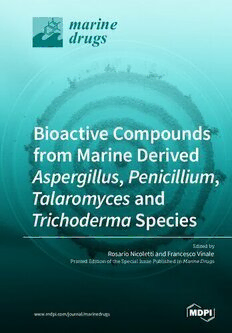Table Of Contentmarine
drugs
Bioactive Compounds
from Marine Derived
Aspergillus, Penicillium,
Talaromyces and
Trichoderma Species
Edited by
Rosario Nicoletti and Francesco Vinale
Printed Edition of the Special Issue Published in Marine Drugs
www.mdpi.com/journal/marinedrugs
Bioactive Compounds from
Marine-Derived Aspergillus,
Penicillium, Talaromyces and
Trichoderma Species
Bioactive Compounds from
Marine-Derived Aspergillus,
Penicillium, Talaromyces and
Trichoderma Species
SpecialIssueEditors
RosarioNicoletti
FrancescoVinale
MDPI•Basel•Beijing•Wuhan•Barcelona•Belgrade
SpecialIssueEditors
RosarioNicoletti Francesco Vinale
CouncilforAgriculturalResearchandEconomics Institute for Sustainable Plant Protection, C.N.R.
andUniversityofNaplesFedericoII and University of Naples Federico II
Italy Italy
EditorialOffice
MDPI
St.Alban-Anlage66
4052Basel,Switzerland
This is a reprint of articles from the Special Issue published online in the open access journal
MarineDrugs (ISSN 1660-3397) from 2017 to 2018 (available at: https://www.mdpi.com/journal/
marinedrugs/specialissues/bioactivecompoundsfrommarine)
Forcitationpurposes,citeeacharticleindependentlyasindicatedonthearticlepageonlineandas
indicatedbelow:
LastName,A.A.; LastName,B.B.; LastName,C.C.ArticleTitle. JournalNameYear,ArticleNumber,
PageRange.
ISBN978-3-03897-980-7(Pbk)
ISBN978-3-03897-981-4(PDF)
CoverimagecourtesyofFrancescoVinale.
(cid:2)c 2019bytheauthors. ArticlesinthisbookareOpenAccessanddistributedundertheCreative
Commons Attribution (CC BY) license, which allows users to download, copy and build upon
publishedarticles,aslongastheauthorandpublisherareproperlycredited,whichensuresmaximum
disseminationandawiderimpactofourpublications.
ThebookasawholeisdistributedbyMDPIunderthetermsandconditionsoftheCreativeCommons
licenseCCBY-NC-ND.
Contents
AbouttheSpecialIssueEditors . . . . . . . . . . . . . . . . . . . . . . . . . . . . . . . . . . . . . vii
RosarioNicolettiandFrancescoVinale
Bioactive Compounds from Marine-Derived Aspergillus, Penicillium, Talaromyces and
TrichodermaSpecies
Reprintedfrom:Mar.Drugs2018,16,408,doi:10.3390/md16110408 . . . . . . . . . . . . . . . . . 1
Wensheng Li, Ping Xiong, Wenxu Zheng, Xinwei Zhu, Zhigang She, Weijia Ding and
ChunyuanLi
Identification and Antifungal Activity of Compounds from the Mangrove Endophytic
FungusAspergillusclavatusR7
Reprintedfrom:Mar.Drugs2017,15,259,doi:10.3390/md15080259 . . . . . . . . . . . . . . . . . 4
SuradetButtachon,AliceA.Ramos,AˆngelaIna´cio,TidaDethoup,Luı´sGales,MichaelLee,
PauloM.Costa,ArturM.S.Silva,NazimSekeroglu,EduardoRocha,MadalenaM.M.Pinto,
Jose´A.PereiraandAnakeKijjoa
Bis-IndolylBenzenoids,HydroxypyrrolidineDerivativesandOtherConstituentsfromCultures
oftheMarineSponge-AssociatedFungusAspergilluscandidusKUFA0062
Reprintedfrom:Mar.Drugs2018,16,119,doi:10.3390/md16040119 . . . . . . . . . . . . . . . . . 14
Weiyi Wang, Yanyan Liao, Chao Tang, Xiaomei Huang, Zhuhua Luo, Jianming Chen and
PengCai
Cytotoxic and Antibacterial Compounds from the Coral-Derived Fungus Aspergillus
triticiSP2-8-1
Reprintedfrom:Mar.Drugs2017,15,348,doi:10.3390/md15110348 . . . . . . . . . . . . . . . . . 36
Elena V. Ivanets, Anton N. Yurchenko, Olga F. Smetanina, Anton B. Rasin,
Olesya I. Zhuravleva, Mikhail V. Pivkin, Roman S. Popov, Gunhild von Amsberg,
Shamil Sh. Afiyatullov and Sergey A. Dyshlovoy
Asperindoles A–D and a p-Terphenyl Derivative from the Ascidian-Derived Fungus Aspergillus
sp. KMM 4676
Reprintedfrom:Mar.Drugs2018,16,232,doi:10.3390/md16070232 . . . . . . . . . . . . . . . . . 46
Beiye Yang, Weiguang Sun, Jianping Wang, Shuang Lin, Xiao-Nian Li, Hucheng Zhu,
ZengweiLuo,YongboXue,ZhengxiHuandYonghuiZhang
ANewBrevianeSpiroditerpenoidfromtheMarine-DerivedFungusPenicilliumsp.TJ403-1
Reprintedfrom:Mar.Drugs2018,16,110,doi:10.3390/md16040110 . . . . . . . . . . . . . . . . . 58
Amira A. Goda, Abu Bakar Siddique, Mohamed Mohyeldin, Nehad M. Ayoub and
Khalid A. El Sayed
The Maxi-K (BK) Channel Antagonist Penitrem A as a Novel Breast
Cancer-Targeted Therapeutic
Reprintedfrom:Mar.Drugs2018,16,157,doi:10.3390/md16050157 . . . . . . . . . . . . . . . . . 67
De-Sheng Liu, Xian-Guo Rong, Hui-Hui Kang, Li-Ying Ma, Mark T. Hamann and
Wei-Zhong Liu
Raistrickiones A−E from a Highly Productive Strain of Penicillium raistrickii Generated through
Thermo Change
Reprintedfrom:Mar.Drugs2018,16,213,doi:10.3390/md16060213 . . . . . . . . . . . . . . . . . 88
v
RosarioNicoletti,MariaMichelaSalvatoreandAnnaAndolfi
SecondaryMetabolitesofMangrove-AssociatedStrainsofTalaromyces
Reprintedfrom:Mar.Drugs2018,16,12,doi:10.3390/md16010012 . . . . . . . . . . . . . . . . . . 99
WenjingWang,XiaoWan,JunjunLiu,JianpingWang,HuchengZhu,ChunmeiChenand
YonghuiZhang
TwoNewTerpenoidsfromTalaromycespurpurogenus
Reprintedfrom:Mar.Drugs2018,16,150,doi:10.3390/md16050150 . . . . . . . . . . . . . . . . . 114
vi
About the Special Issue Editors
Rosario Nicoletti conducts research in the field of mycology and plant pathology, with special
reference to bioactive products of fungi, their role in the ecological relationships with other
organisms, and perspectives for their pharmacological exploitation. He has authored over 160
scientific papers, including articles in international journals, book chapters, and communications
at national and international conferences. He has served as a project reviewer and as a referee for 60
international scientific journals. He is an Editorial Board Member for the journal Agriculture,
published by MDPI AG.
Francesco Vinale is the author of over 100 scientific papers, including articles published in scientific
journals, reviews, book chapters, and abstracts and proceedings of national and international
congresses. He is a reviewer for several international journals and collaborates with various
companies that are involved in the development and commercialization of biopesticides and, also,
methods to remediate contaminated soil and water by using microorganisms. He is responsible for
or involved in numerous research projects. Research interests: (i) purification and characterization
of bioactive microbial metabolites; (ii) role of microbial secondary metabolites in complex
plant/antagonist/pathogen interactions; (iii) interaction between microbial antagonists, plants, and
pathogens using metabolomic approaches; (iv) application of beneficial microorganisms and/or their
metabolites in agriculture and industry; (v) microbial metabolites involved in pathogenic events; (vi)
microbial enzymes or metabolites in decontamination of polluted soil and water (bioremediation);
(vii) biochemical characterization of fungal antagonists and pathogens.
vii
marine drugs
Editorial
Bioactive Compounds from Marine-Derived
Aspergillus, Penicillium, Talaromyces and
Trichoderma Species
RosarioNicoletti1,*,†andFrancescoVinale2
1 CouncilforAgriculturalResearchandAgriculturalEconomyAnalysis,OFAResearchCentre,
81100Caserta,Italy
2 InstituteforSustainablePlantProtection,NationalResearchCouncil,80055Portici(NA),Italy;
[email protected]
* Correspondence:[email protected];Tel.:+39-081-253-9199
† Currentaddress:DepartmentofAgriculture,UniversityofNaples‘FedericoII’,80055Portici,Italy.
Received:19October2018;Accepted:24October2018;Published:26October2018
The impact of bioactive compounds from natural sources on human life, particularly
in pharmacology and biotechnology, has challenged the scientific community to explore new
environmentalcontextsandtheassociatedmicrobialdiversity. Asthelargestfrontierinbiological
discovery,thesearepresentsoneofthemostconducivereservoirsoforganismsproducingsecondary
metaboliteswithinterestingbiologicalactivities.Inthelastdecadesfungihavereceivedincreasing
attention,bothfortheirpervasiveoccurrenceinseveralhabitatsandfortheirwidespreadaptitude
todevelopsymbioticassociationswithhigherorganisms. Inmanycases,fungalstrainshavebeen
reportedastherealproducersofdrugsthatwerepreviouslyascribedtomarineplantsandanimals[1,2].
SpeciesofthegeneraAspergillus,Penicillium,TalaromycesandTrichodermaarerenownedproducers
ofbioactivecompounds[3–5].Untilrecentlytheywereconsideredas‘terrestrial’fungiwithmerely
accidental discoveries in marine environments. However, recent findings have demonstrated
thatactuallytheyareveryabundantinmarineenvironmentsandsometimesestablishsymbiotic
interactionswithhigherorganisms(e.g.,thecaseofAspergillussydowiiongorgonians[6]).Itcanbe
assumedthatmanyspeciesbelongingtothesegeneraofAscomycetesarerathereclecticintheirability
toadaptandthriveinverydifferentenvironmentalconditions. Thus,atleastintermsofspecies
number,AspergillusandPenicilliumrespectivelyrepresentthefirstandthesecondmostabundant
generaoffilamentousfungireportedfrommarinecontexts[4,7].
Papers included in this special issue deal with marine-derived species of Aspergillus,
Penicillium,TalaromycesandTrichoderma,providingagoodoverviewoftheirbiosyntheticpotential.
NewcompoundshavebeenisolatedandcharacterizedfromstrainsofA.candidus[8],A.clavatus[9],
A.tritici[10],P.raistrickii[11],andTalaromycespurpurogenus[12]. Twopapersreporttherecovery
of strains of Aspergillus and Penicillium [13,14] that could not be ascribed to known species,
thusunderlyingthatnewfindingsfromthemarineenvironmentcanexpandthecurrenttaxonomic
diversityandeventuallycontributetoamorecoherentclassification. Moreover,dataconcerning
severalknownfungalcompoundswerediscussed,providingcluesforabettercomprehensionof
theirbiosyntheticprocesses,andausefulindicationforchemotaxonomy. Taxonomicimplications
andtheirrelevanceforacorrectintegrationofnewdatainthecurrentknowledgehavebeenalso
discussedinareviewonmangliculousstrainsofTalaromyces,aftertherecentseparationofthisgenus
fromPenicillium[15].
Severalnovelcompoundscharacterizedfromtheculturefiltratesofthesefungipresentsome
original or uncommon structures, such as: the raistrickiones, that represent the first case of
3,5-dihydroxy-4-methylbenzoylderivativesofnaturalproducts[11];theindole-diterpenealkaloids
asperindolesCandD,containinga2-hydroxyisobutyricacidresidue[13]; 9,10-diolhinokiicacid,
Mar.Drugs2018,16,408;doi:10.3390/md16110408 1 www.mdpi.com/journal/marinedrugs

